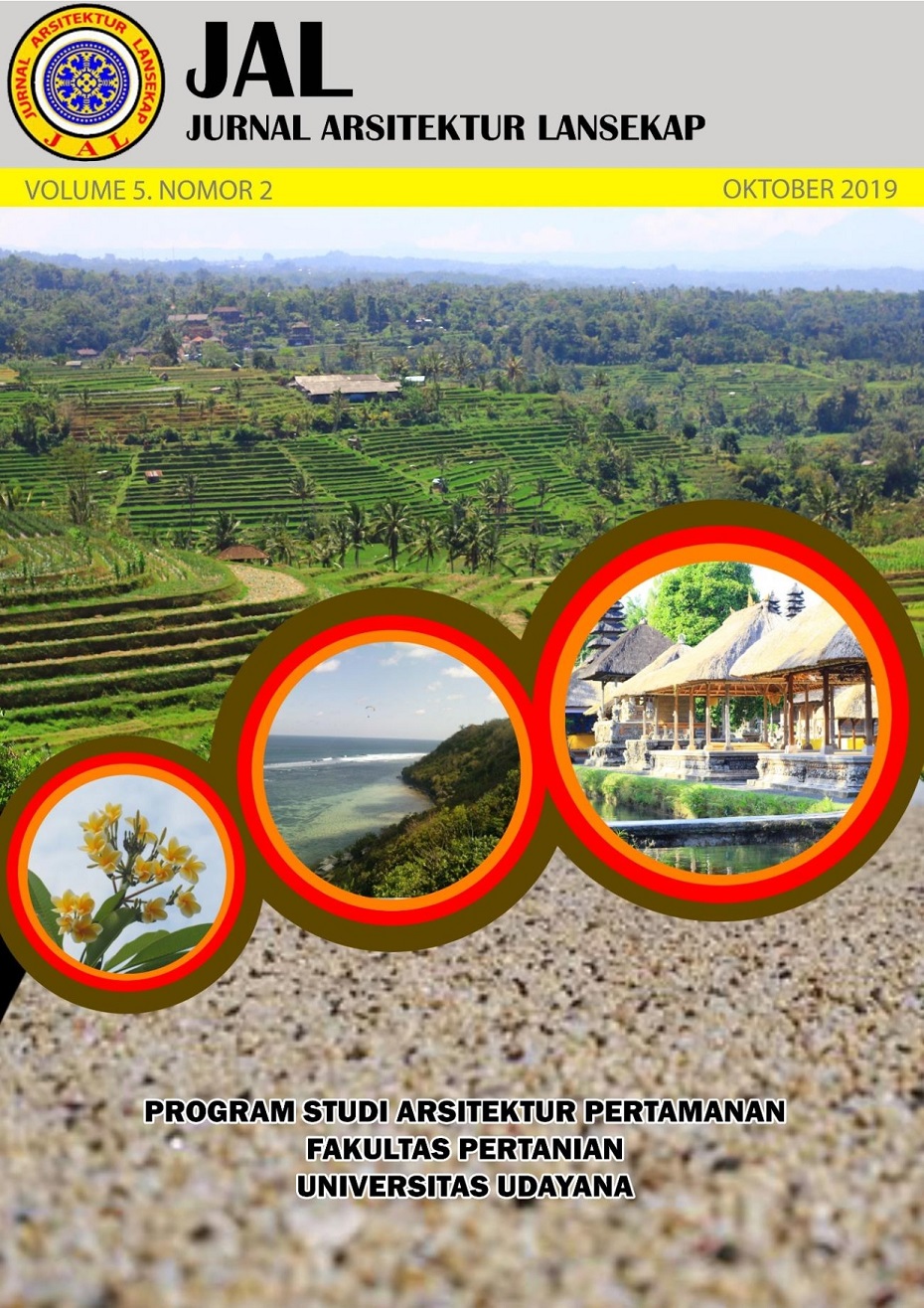Identifikasi tanaman penyerap Pb di tiga ruas jalan Kota Denpasar
Abstract
Plant leaf capability identification to absorb Pb in three sections of Denpasar city streets. Plant as a soft
element on landscape’s road, can also function as a pollutant absorber. Plants ability to absorb pollutants,
depending on their characters, especially leaves morphology and its environment. Gajah Mada, P. B. Sudirman
and Letda Tantular are three roads in Denpasar City which have highly activity of human and vehicle based on
their location in center of trade, education and government area. Humans in this area potentially risk of
exposure to lead (Pb) of motor vehicle emissions. One solution to minimize Pb exposure to humans is to use
plants that can absorb dust and Pb along those roads. Survey's result shows that the dominant plants in Letda
Tantular roadside are Lagerstroemia speciosae and Samanea saman, while Plumeria rubra and Callistemon
viminalis are dominant in Gajah Mada, at P. B. Sudirman, Cerbera manghas and Polyalthia longifolia are
dominating. The leaf of those plants then analyzed to know their capability in accumulate dust and Pb
absorption. Laboratory test showed that Lagerstroemia speciosae leaves have the best ability to absorb dust
(5.80472 mg/cm2) and absorb Pb (5.04133 mg/kg). Morphology’s character of Lagerstroemia speciosae leaves
is stiff, with a rough surface but not hairy. Lagerstroemia speciosae has row and dense canopies with moderate
plant height, this plant roots also didn't damage roads. Therefore, Lagerstroemia speciosae is one of the proper
plant to use as pollutant absorber especially on fairly large roads with dense human activities.
Downloads
References
Dwiputri, D. A. 2015. Toleransi Spesies Pohon terhadap Pencemaran Udara di Kawasan Industri Krakatau Kota Cilegon. Thesis. Sekolah Pascasarjana Institut Pertanian Bogor. Bogor.
Fathia, L. A. N., M. Baskara, Sitawati. 2015. Analisis kemampuan tanaman semak di median jalan dalam menyerap logam berat Pb. Jurnal Produksi Tanaman, 3(7):528 – 534.
Hiadun, K.R., D. R. Parker, J. T. Trumble. 2015. Cadmium, copper, and lead accumulation and bioconcentration in the vegetative and reproductive organs of Raphanus sativus: implications for plant performance and pollination. Journal of Chemical Ecology, 10p.
Manik, S. T., W. Prihanta, E. Purwanti. 2015. Analisis Kandungan Timbal (Pb) pada Daun Tamarindus indica dan Samanea saman di Kecamatan Garum Kabupaten Blitar. Seminar Nasional XII Pendidikan Biologi FKIP UNS: 816-821.
Patra, A. D., N. Nasrullah, E. L. Sisworo. 2004. Kemampuan berbagai jenis tanaman menyerap gas pencemar udara (NO2). Risalah Seminar Ilmiah Penelitian dan Pengembangan Aplikasi Isotop dan Radiasi. 8p
Rai, P. K., L. L. S. Panda. 2013. Dust Capturing Potential and Air Pollution Tolerance Index (APTI) of some road side tree vegetation in Aizwal, Mizoram, India: an Indo-Burma hot spot region. Air Quality, Atmosphere & Health 7(1):93-101.
Ram, S. S., S. Majumder, P. Chaudhuri, S. Chanda, S. C. Santra, P. K. Maiti, M. Sudarshan, A. Chakraborty. 2012. Plant canopies: bio-monitor and trap for re-suspended dust particulates contaminated with heavy metals. Mitig Adapt Strateg Glob Change, 10p.
Shahid, M., C. Dumat, S. Khalid, E. Schreck, T. Xiong, N. K. Niazi. 2016. Foliar heavy metal uptake, toxicity and detoxification in plants: A comparison of foliar and root metal uptake. Journal of Hazardous Materials 325:36-58.
Simon E., M. Braun, A. Vidic, D. Bogyó, I. Fábián, B. Tóthmérész. 2011. Air pollution assessment based on elemental concentration of leaves tissue and foliage dust along an urbanization gradient in Vienna. Environmental Pollution, 59:1229-1233.
Sternbeck, J., A. Sjodin, K. Andreasson. 2002. Metal emissions from road traffic and the influence of resuspension—results from two tunnel studies. Atmospheric Environment 36:4735–4744.
Syamsoedin, I. 2010. Kajian Status Iptek dan Pengembangan Ekosistem Hutan di Perkotaan. Bogor: Badan Penelitian dan Pengembangan Kehutanan.
Taihuttu, H. N. 2001. Studi Kemampuan Tanaman Jalur Hijau Jalan sebagai Penjerap Partikulat Hasil Emisi Kendaraan Bermotor. Thesis. Program Pascasarjana Institut Pertanian Bogor. Bogor.
An author who publishes in the Jurnal Arsitektur Lansekap (JAL) agrees to the following terms:
- Author retains the copyright and grants the journal the right of first publication of the work simultaneously licensed under the Creative Commons Attribution-ShareAlike 4.0 License that allows others to share the work with an acknowledgement of the work's authorship and initial publication in this journal
- Author is able to enter into separate, additional contractual arrangements for the non-exclusive distribution of the journal's published version of the work (e.g., post it to an institutional repository or publish it in a book) with the acknowledgement of its initial publication in this journal.
- Author is permitted and encouraged to post his/her work online (e.g., in institutional repositories or on their website) prior to and during the submission process, as it can lead to productive exchanges, as well as earlier and greater citation of the published work (See The Effect of Open Access).
Read more about the Creative Commons Attribution-ShareAlike 4.0 Licence here: https://creativecommons.org/licenses/by-sa/4.0/.







